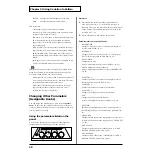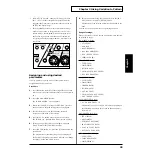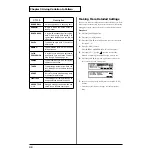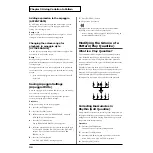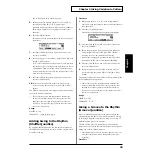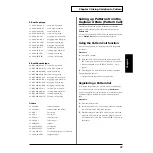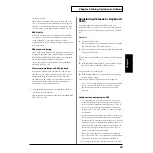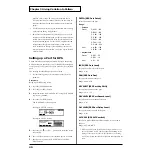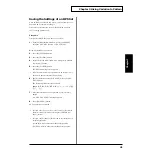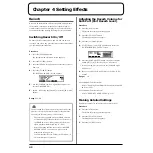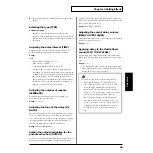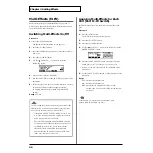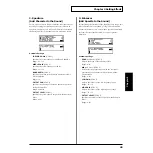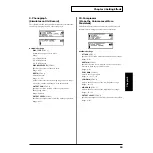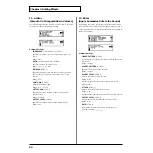
39
Chapter 3 Giving Variation to Pattern
Chapter3
the keyboard pad.
If you connect a pedal switch (optional: DP-2, DP-6, FS-
5U etc.) and set the System parameter “Pedal Assign” to
“HOLD,” the pedal switch can be used to hold the RPS.
refer to "Setting up the pedal (PEDAL ASSIGN) "(p. 117).
RPS Modify
While you are pressing a keyboard pad to play an RPS,
you can move the Patch parameter knobs to modify the
sound of the RPS. If you are pressing two or more
keyboard pads, You can modify the sound of the pad that
was last pressed.
RPS playback timing
If you use RPS while a pattern is playing back, the phrase
will start in synchronization with the beat of the pattern.
By changing the RPS TRIG QTZ setting, you can modify
the timing at which the RPS will play back.
refer to "Specifying the timing for RPS playback (RPS
TRIGGER QTZ) "(p. 121).
Maximum simultaneous RPS playback
Even while a pattern is playing back, the MC-307 can
play back up to 8 phrases simultaneously. However, if
phrases with large amounts of data are played back
simultaneously, the timing may lag behind or notes may
be interrupted. If this occurs, decease the number of
phrases that you play simultaneously.
* RPS can also be played from an external MIDI keyboard, as
well as from the keyboard pads.
refer to "Specifying the channel that will control RPS (RPS
CTRL CH) "(p. 124).
Registering Phrases in Keyboard
Pads
The phrases that are assigned to an RPS set can be re-
assigned whenever you wish. You will find it convenient to
assign your favorite or frequently-used phrases in one RPS
set.
Procedure
1.
Press the [PTN] button.
Select the pattern you want to assign to the pad using the
[VALUE] dial or the [INC/DEC] buttons.
2.
All parts other than the one played using RPS are muted
with the MUTE button.
Next we must select the RPS set in which we will assign the
phrase.
3.
With the [RPS] button held down, select a RPS set using
the [VALUE] dial or the [INC/DEC] buttons.
Assign patterns to keyboard pads.
4.
Hold down[RPS] button, and press Keyboard pad you
want to assign a pattern.
This completes keyboard pad and pattern assignment.
* P: 241–P: 710 contain patterns which are prepared specifically
for use with RPS. You might find it convenient to assign
phrases from these patterns to use as fill-ins, or for other
situations.
Cautions when assigning an RPS
* It is not possible to assign phrases of two or more parts to a
single keyboard pad. You must mute all but one of the parts,
the one with the desired phrase, before assigning it. If any of
the extra parts have been left unmuted when you make your
assignment, the “CANNOT ASSIGN!” message will appear
in the display.
* If after assigning a phrase from a user pattern as an RPS, you
then modify the playback data of the pattern which contains
that phrase, be aware that any change to the phrase will also be
reflected in the way it is played back by RPS. For example, if
you delete the musical data of the pattern which contains the
phrase that you assigned, there will be no sound when you
attempt to play back that phrase by RPS.
* Even if you assign the phrase of a part that has a setting of
“EXT” for its SEQ OUT (P. 23) parameter, the musical data
of that phrase will not be transmitted from MIDI OUT.
* If you assign a phrase from a part that uses M-FX, the RPS




